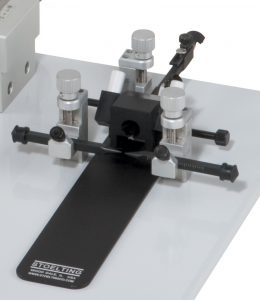- Model 50264 (Gas Anesthesia Platform and Mouse Mask Pictured) can be used with the Mouse/Neonatal Rat Adaptor (model 51625) which is used on the ‘Rat and Mouse’ Lab Standard model stereotaxics, the Just for Mice (model 51725) or as a stand-alone platform for dorsal surgery.
- Model 50267 (Gas Anesthesia Platform and Rat Mask) allows for anesthetization and positioning of the rat outside of a stereotaxic device. It also is an ideal platform for dorsal surgery. The platform provides a means of easy movement of an anesthetized rat to and from a stereotaxic apparatus or other device.
- The Gas Anesthesia mask is installed over the incisor bar, with the cone opening toward the open “Uâ€. The animal (rat or mouse) is installed by placing its teeth over the incisor bar, and sliding the adaptor forward until the cone is snug about the animal’s nose, thereby substituting for the nose clamp. Once the teeth and the cone provide a snug, stable hold, the platform is lifted onto an appropriate stereotaxic device.
- Model 51770 (Lab Standard) includes the standard rat base with a modular mouse adapter.
- For a better explanation on the difference between Lab Standardand New Standard please refer HERE.
- Model 51725 (Just for Mice Not Pictured) allows the researcher to hold and prepare two mice, or neonatal rats, at the same time with its dual base setup
Stereotaxic Gas Anesthesia Masks With Platform

Anesthesia Masks enable gas anesthesia to be used with rats and mice while operating.The Gas Anesthesia Platform and Mask models provide for precise and secure positioning of an animal during anesthesia and surgery.
|
|||||||||||||||||
Gas Anesthesia Masks for Stereotaxics

Designed for mice or rats in a Stereotaxic Instrument. The Gas Adaptors for Stereotaxic instruments, enable gas anesthesia of rats or mice in a Lab Standardâ„¢ or other stereotaxic instrument, without exposing the researcher to the gas. The Gas Anesthesia mask is installed by removing the nose clamp from the standard rat adaptor, and sliding the adaptor over the incisor bar, with the cone opening toward the open “U”. The animal (rat or mouse) is installed by placing its teeth over the incisor bar, and sliding the adaptor forward until the cone is snug about the animal’s nose, thereby substituting for the nose clamp. The teeth and the cone provide a snug, stable hold. Anesthetic gas flows in the tubing connector, past the animal’s nose, and out the other side, where it may be routed to recycling, exhaust, or gas analysis instruments.
|
|||||||||
Mouse and Neonatal Rat Adaptor

This adaptor allows using mice and rats even if you only have a rat stereotaxic frame. This adaptor is designed for use with traditional ‘U’-framed stereotaxic instruments like the Classic Lab Standard series. Ear and bite bar heights can be independently adjusted to accommodate all needs.
|
|||||||||
Motorized Lab|New Standard, Rat and Mouse

The Rat/Mouse Stereotaxic Instruments provide users with the ability to perform surgeries on both Mice and Rats on the same base. Motorizied versions of these Stereotaxics include customized motors and the state-of-the-art StereoDrive software to allow motorized, computer controlled stereotaxic positioning in all 3 orthogonal axes. The intuitive movement control and integrated stereotaxic atlas enables unprecedented accuracy and higher throughput in all stereotaxic applications.
|
|||||||||
Motorized Lab Standard, Rat

The Motorized Rat Stereotaxics combines the standard design with customized motors and state-of-the-art software. Integrated with popular stereotaxic atlases the StereoDrive software allows motorized, computer controlled stereotaxic positioning in all 3 orthogonal axes. The intuitive movement control enables unprecedented accuracy and higher throughput in all stereotaxic applications.
|
|||||||||
Motorized Just for Mouse

The Mouse-specific Stereotaxic Instruments were specifically designed for use with knock-out and transgenic mice. Motorized Mouse Stereotaxic Instruments includes customized motors and the state-of-the-art StereoDrive software to allow motorized, computer controlled stereotaxic positioning in all 3 orthogonal axes. The intuitive movement control and integrated stereotaxic atlas enables unprecedented accuracy and higher throughput in all stereotaxic applications.
|
|||||||||

